An Ancient Futuristic Melodic Source
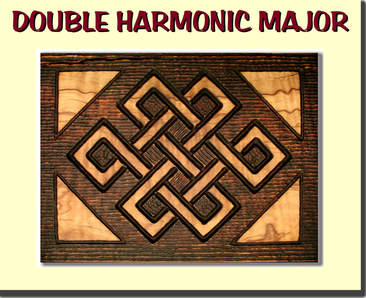
This scale (and its modes) is the Western equivalent of an early tone collection that is indigenous to Greece, Turkey and the Balkans, as well as North Africa & India, where in the south (Karnataka), it's the first scale (Melakarta) taught to young Carnatic music students.
Because of its unique interval make-up, consisting of four Augmented 2nds, as well as its resulting "Eastern" flavor (to Western ears, at least), it has remained a challenge to harmonize in the normal fashion, as many of the usual harmonic cadences and resolutions are not available or functional within its scale system. At the same time, it remains as a largely untapped source of inspiration and material for the improviser and composer willing to investigate and experiment.

Double Harmonic Major is a palindromic scale, meaning that its interval scheme, expressed in semitones (1-3-1-2-1-3-1) - is identical in both ascending and descending directions - as from C to C in the graphic above. For instance, the word “racecar” - with its identical spelling frontwards and backwards - is an example of a palindromic word.
As to its interval make-up, this scale contains 4 minor 2nds (C-Db, E-F, G-Ab, B-C), 2 Major 2nds (F-G, B-Db), 4 augmented 2nds (functioning as minor 3rds - Db-E, E--G, F-Ab, Ab-B), 5 Major 3rds (C-E, Db-F, E-Ab, G-B, Ab-C), 4 Perfect 4ths (C-F, G-C, Ab-Db, B-E), 2 tritones (Db-G, F-B), 4 Perfect 5ths (as inversions of P4ths - C-G, Db-Ab, E-B, F-C).
6ths and 7ths are, of course, the opposite quality inversions of 3rds and 2nds, respectively.
C - C I. Double Harmonic Major, Ionian b2 b6, Maymalavagowla (Melakarta #15), Byzantine
C Maj, C b2, Csus4, C+, C Maj7, C Maj7+5
Db - Db II. Lydian #2 #6, Rasikapriya (Melakarta #72)
Db Maj, Dbmin, Dbdim, Db Maj7, Db Maj7b5, Dbmin7, Db7, Db7b5, Dbmi7b5, Db7#9
E - E iii. Ultra Phrygian
E Maj, E Maj6, Emin, Emin6, E+, E b2,
F - F iv. Hungarian Minor, Double Harmonic Minor, Simhendramadhyamam (Melakarta #57)
Fmin, Fdim, F b5, Fmin+7, Fdim+7
G - G V. Asian, Oriental
G Maj, G b2, G b5, Gsus, G7b5
Ab - Ab VI. Ionian Augmented #2
Ab+, Ab Maj7+5
B - B vii. Locrian bb3 bb7
B b2b5, Bsus b5, Db/B
The list of triads and seventh chords is by no means complete. A more extensive and notated list is part of this month's Shortbook™, "Double Harmonic Minor - An Ancient Futuristic Melodic Source" which is available for immediate download via the link at the bottom of the page.
It's interesting to note that the second mode (II) - Lydian #2 #6, is the one which yields the most diversity in its inherent chord types and qualities, mainly because it contains both Maj and min 3rds & 7ths, as well as both perfect and diminished 5ths.
It therefore has a strong pull (when playing this scale without a drone or other accompaniment) to a Db tonality - as a type of Bebop Lydian Dominant, bII7 tritone substitution – eventually (possibly) resolving to C, the scale's tonic (I) chord.
This is a very common harmonic movement in Jazz. "Well You Needn't" and "Epstrophy" are two Thelonious Monk compositions that quickly come to mind, as tunes which contain sections that alternate between these two chord types.
Below are two of the twenty-four 4 bar melodic examples in "Double Harmonic Major". The examples shown here are in C, but are transposed to all 12 keys in the book. In these example a bass line was added after the fact, but no harmonies given.
Example #2 below has a pretty clear bII7 - I (Db7 - C) harmonic outline, through the melody as well as the bass line; with each chord lasting 2 bars apiece.
So don't give up on this baby! As an ancient / futuristic melodic source, it's got nothing but potential – depending on our imagination - to be heard in ways yet to be.


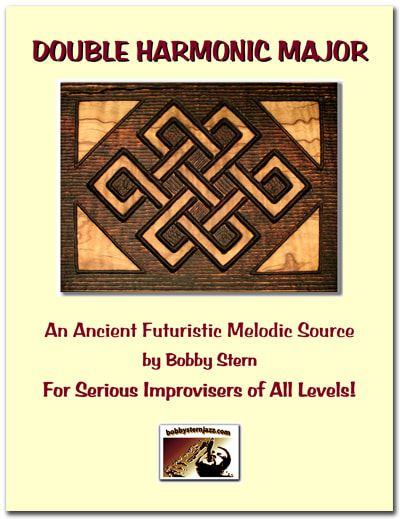
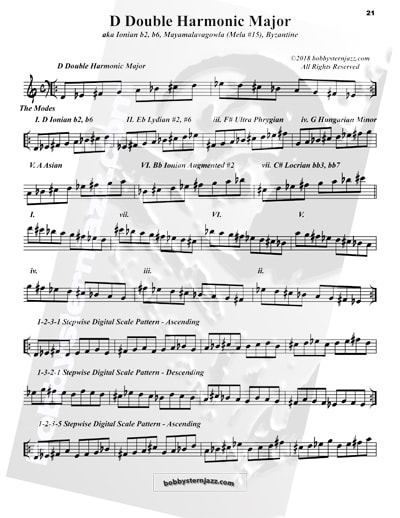
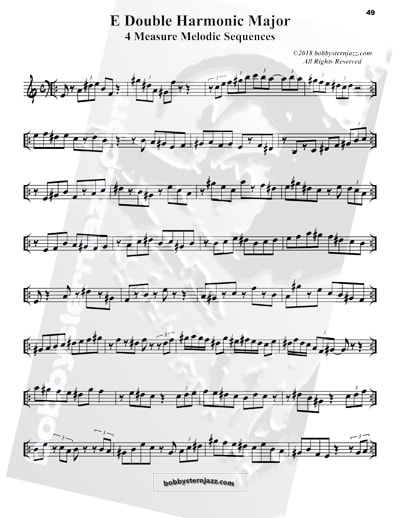
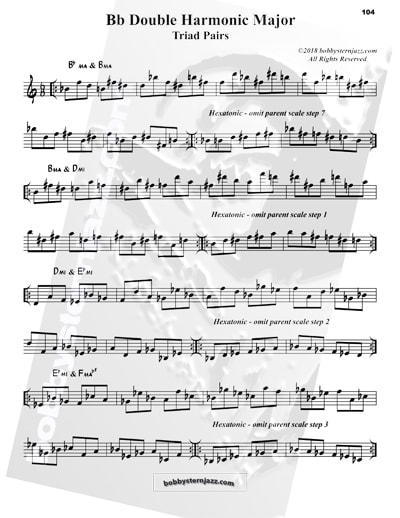

 RSS Feed
RSS Feed








